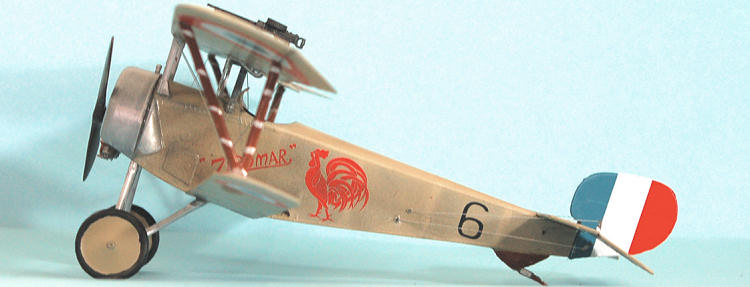
Special Hobby 1/32 Nieuport 11 'French Aces'
| KIT #: | 32015 |
| PRICE: | $57.00 SRP |
| DECALS: | Three options |
| REVIEWER: | Tom Cleaver |
| NOTES: | Multi-media: resin gas tank, engine, cockpit details, photoetch seat belts, instruments, windscreen, control horns and turnbuckles; injection plastic air frame. |

| HISTORY |
Designed by Gustave Delage, the Nieuport 11, known as the Bébé for
its small size - being a single-seat development of the two-seat Nieuport 10 -
first appeared as a prototype in 1915 and became famous as one of the aircraft
that ended the “Fokker Scourge” in 1916.
The design was known as a “sesquiplane,” having a standard two-spar upper
wing, and a single-spar lower wing with less than half the wing area of the
upper wing. This was originally
developed in the Nieuport 10 to provide the maneuverability of a biplane with
the downward visibility of a “parasol” monoplane.
The primary drawback of the design is the likelihood the lower wing can
twist under aerodynamic forces and break off unless strongly built.
Powered by an 80 h.p. Gnome-LeRhone rotary, the Nieuport was constructed
as lightly as possible to give it the performance it had.
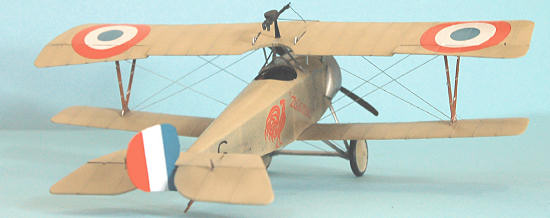 The Nieuport 11 was provided to the French Aéronautique Militaire, the
Royal Naval Air Service, the Dutch Air Service, Belgian Air Service, the
Imperial Russian Air Service, the Serbian Air Force and the
Italian Air Force, where 646 were produced under license by the Macchi
company.
The Nieuport 11 was provided to the French Aéronautique Militaire, the
Royal Naval Air Service, the Dutch Air Service, Belgian Air Service, the
Imperial Russian Air Service, the Serbian Air Force and the
Italian Air Force, where 646 were produced under license by the Macchi
company.
Ordered into production in December 1915, the first Escadrilles de
Chasse equipped with the Bébé in January and 90 were at the front by
The Nieuport 11 saw widespread service after the
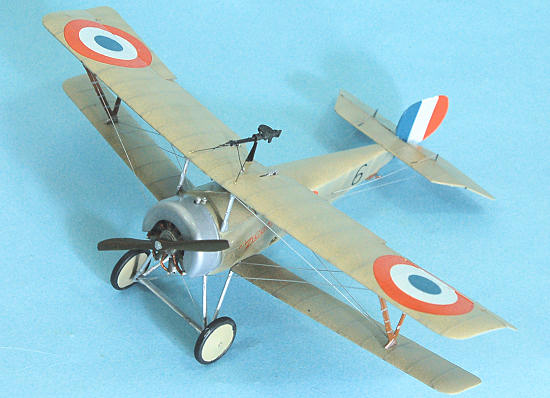 Such was the pace of development, the Bébé was being replaced by
the first of the improved Nieuport 17 by March 1916, with the last ones leaving
the Western Front that summer, though they remained in Italian and Russian
service till the end of the year.
Such was the pace of development, the Bébé was being replaced by
the first of the improved Nieuport 17 by March 1916, with the last ones leaving
the Western Front that summer, though they remained in Italian and Russian
service till the end of the year.
Among the first French pilots to achieve success and become an ace flying
the Nieuport 11 was Paul Albert Pierre Tarascon of Escadrille de Chasse N62.
Tarascon had entered the French Army in 1901 at the age of 19, serving
with the Colonial Infantry. He
became interested in aviation and started learning to fly in 1911; he was
involved in a bad crash and his right foot was amputated.
When the war broke out in 1914, Tarascon volunteered for the Aviation
Militaire and completed flight training in January 1915, after which he was
assigned as an instructor. With the
losses that came from the “Fokker Scourge” in late 1915, he managed to be
reassigned to combat flying, first with N31 and then N3, on Nieuport 10s. In
April 1916 he was assigned to N62,
where he “found his eye” and began his successful career flying his first “Zigomar,”
a Nieuport 11. By September, Tarascon had eight victories and was awarded the
Medaille Militaire and Legion d'Honneur. The unit re‑equipped with
the SPAD
| THE KIT |
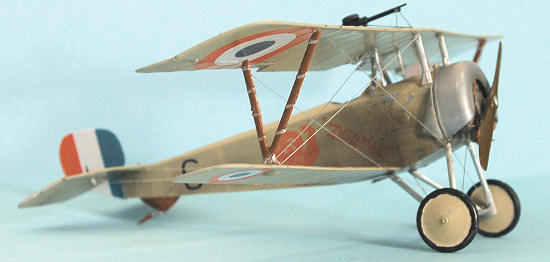 The first kit of a Nieuport 11 was released in the late 1950s by
The first kit of a Nieuport 11 was released in the late 1950s by
This kit by Special Hobby is the first 1/32 scale kit of the Nieuport 11. It is a multi-media kit, with a limited-run injection plastic airframe, resin engine, gas and oil tanks, and cockpit details. The photoetch seatbelts, instrument faces, windscreen, control horns and turnbuckles are done by Eduard. Markings are provided for three Nieuport 11s flown by Paul Tarascon, Escadrille N62; Pierre Dufaur de Gavardie, Escadrille N12; and Jean Navarre, Escadrille N67.
| CONSTRUCTION |
Since this is a limited-run kit, the first thing I did was clean up the
flash off the plastic parts, and then cut the major resin parts off their
molding blocks.
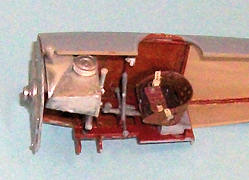 I then cut the ailerons off the upper wing and glued them in “dynamic”
positions, and also cut off the elevators and glued them in the “drooped”
position to the horizontal stabilizer.
I then cut the ailerons off the upper wing and glued them in “dynamic”
positions, and also cut off the elevators and glued them in the “drooped”
position to the horizontal stabilizer.
I painted the fuselage interior and the cockpit parts to simulate wood.
I also drilled out the pilot’s seat in the Nieuport style.
When I assembled the cockpit, I made sure the flying controls were
positioned to match the ailerons, elevators and rudder.
There was a noticeable seam along the centerline, which I only conquered
eventually with cyanoacrulate glue sanded smooth, with an application of Tamiya
“Mr. Surfacer” to get rid of it. I
left the model further unassembled while I proceeded to paint it.
| COLORS & MARKINGS |
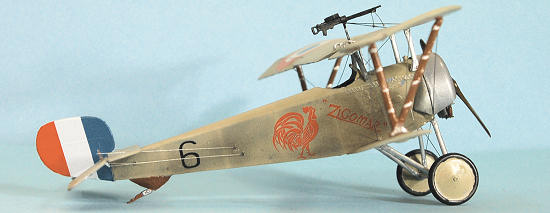 I “pre-shadowed” the model along the ribs of the flying surfaces, and
then gave “depth” to the fuselage by darkening the areas between the airframe.
The model was then painted with Gunze-Sangyo “Sail Color,” while the
landing gear and cabane struts were painted with Talon acrylic Aluminum along
with the cowling, and the interplane “Vee” struts were painted in my “Ash” color
of yellowish-brown, then painted with Tamiya “Clear Yellow” for varnish.
When dry, I gave the model an overall coat of Xtracrylix Clear Gloss
varnish.
I “pre-shadowed” the model along the ribs of the flying surfaces, and
then gave “depth” to the fuselage by darkening the areas between the airframe.
The model was then painted with Gunze-Sangyo “Sail Color,” while the
landing gear and cabane struts were painted with Talon acrylic Aluminum along
with the cowling, and the interplane “Vee” struts were painted in my “Ash” color
of yellowish-brown, then painted with Tamiya “Clear Yellow” for varnish.
When dry, I gave the model an overall coat of Xtracrylix Clear Gloss
varnish.
The kit decals went on without problem under an application of Micro-Sol.
Once set, I washed the model and gave it a coat of Xtracrylix Clear Satin
varnish.
| FINAL CONSTRUCTION |
I attached the engine and cowling, and then applied exhaust stains over
the airframe with Tamiya “Smoke.”
Rotary engines threw oil everywhere, so there is really no such thing as “too
much.”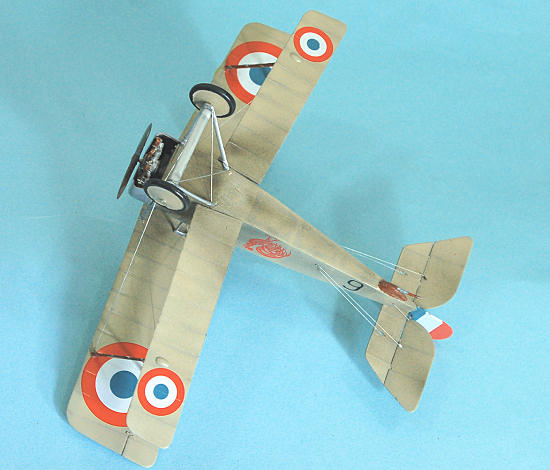
I then attached the cabane struts and the upper wing. I attached the Vee
interplane struts to the upper wing and then attached the lower wings to the
fuselage and the interplane struts, which insured the lower wing had the correct
dihedral. I then attached the
horizontal stabilizer and the rudder, posing it canted.
I finished off with the main landing gear, after “muddying” the wheels
with Tamiya’s weathering set
I made a gun mount using wire, which gave a more petite and accurate look
than the clunkier plastic parts did, and mounted the gun.
I finished off by rigging the model with .008 wire for the flying rigging
and .006 wire for the control wires to the elevators and rudder.
| CONCLUSIONS |
I really like the Nieuport sesquiplanes, and this kit by Special Hobby
comes out looking as petite as it should when it sits next to the Roden SPAD
June 2011
Copyright ModelingMadness.com. All rights reserved. No reproduction in part or in whole without express permission.
If you would like your product reviewed fairly and fairly quickly, please contact the editor or see other details in the Note to Contributors.